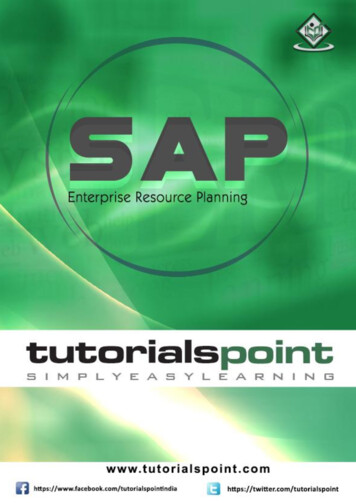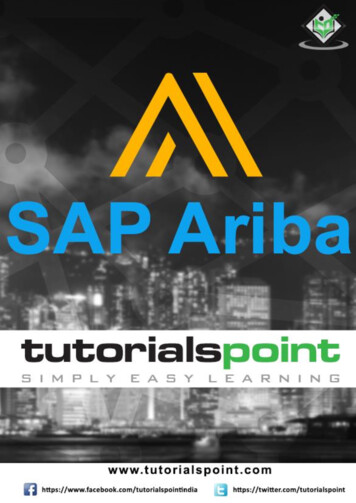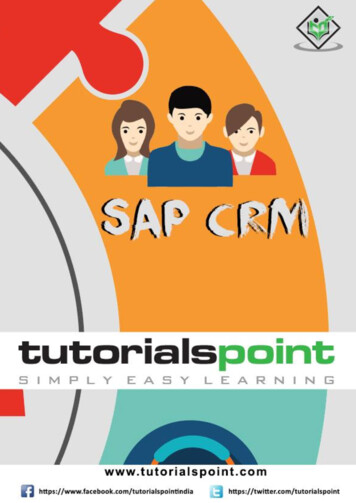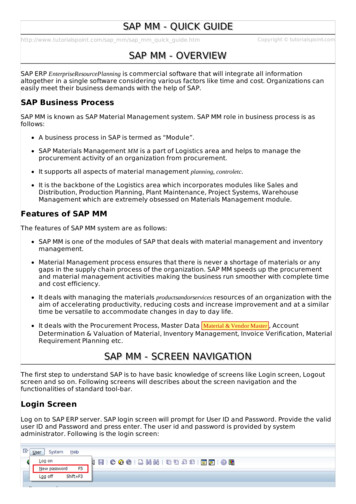
Transcription
SAP SDi
SAP SDAbout the TutorialSAP SD (Sales and Distribution) is one of the significant modules of SAP ERP. It is used tostore the customer and product data of an organization. SAP SD helps to manage theshipping, billing, selling and transportation of products and services of a company.The SAP Logistics module manages customer relationship starting from raising a quotationto sales order and billing of the product or service. This module is closely integrated withother modules like SAP Material Management and PP.This is an introductory tutorial that covers the basics of SAP SD and how to deal with itsvarious modules and sub-modules.AudienceThis tutorial will be extremely useful for professionals who aim to understand the basicsof SAP SD and implement it in practice. It is especially going to help consultants who aremainly responsible for implementing sales, billing, and transportation of products.PrerequisitesIt is an elementary tutorial and you can easily understand the concepts explained herewith a basic knowledge of how an organization deals with their customers and products.However, it will help if you have some prior exposure to inventory and how to deal withbilling and shipping.Copyright & Disclaimer Copyright 2018 by Tutorials Point (I) Pvt. Ltd.All the content and graphics published in this e-book are the property of Tutorials Point (I)Pvt. Ltd. The user of this e-book is prohibited to reuse, retain, copy, distribute or republishany contents or a part of contents of this e-book in any manner without written consentof the publisher.We strive to update the contents of our website and tutorials as timely and as precisely aspossible, however, the contents may contain inaccuracies or errors. Tutorials Point (I) Pvt.Ltd. provides no guarantee regarding the accuracy, timeliness or completeness of ourwebsite or its contents including this tutorial. If you discover any errors on our website orin this tutorial, please notify us at contact@tutorialspoint.comi
SAP SDTable of ContentsAbout the Tutorial . iAudience . iPrerequisites . iCopyright & Disclaimer . iTable of Contents . ii1.SAP SD – INTRODUCTION . 1SAP SD – Organizational Structure . 2Material Management . 3Finance and Accounting . 3Document Flow . 4Process Chain . 52.SAP SD – CUSTOMER AND MATERIAL MASTER DATA . 6Create a Customer Master Record. 63.SAP SD – CREATE PARTNER FUNCTION . 114.SAP SD – CREATE MATERIAL STOCK . 155.SAP SD – CREATE MM FOR SALES VIEW. 176.SAP SD – CUSTOMER ACCOUNT GROUPS . 217.SAP SD – PRE-SALES ACTIVITIES . 24Inquiries . 24Quotation. 24Create Inquiries . 248.SAP SD – CREATE QUOTATIONS . 279.SAP SD – SALES SUPPORT . 29ii
SAP SD10. SAP SD – SALES ORDER PROCESSING . 30Sales Order Processing . 3011. SAP SD – CREATION OF SALES ORDER. 3112. SAP SD – DEFINING A SALES DOCUMENT . 3513. SAP SD – ITEM CATEGORIES . 3714. SAP SD – SCHEDULE LINES CATEGORIES . 4015. SAP SD – COPY CONTROL . 4316. SAP SD – LOG OF INCOMPLETE ITEMS . 4517. SAP SD – PRICING . 49Manual Pricing . 4918. SAP SD – CONDITION RECORD AND TABLE . 50Creating Condition Tables . 5019. SAP SD – CONDITION TECHNIQUES AND TYPES . 5220. SAP SD – ACCESS SEQUENCE . 56Determine Pricing by item Category . 5621. SAP SD – PRICES, SURCHARGES & DISCOUNTS . 59Prices and Types . 59Surcharges and Discounts . 5922. SAP SD – PRODUCT PROPOSALS . 6123. SAP SD – LISTING, DETERMINATION & EXCLUSION. 6224. SAP SD – SALES ORDER TYPES. 65Types of Sales Orders . 65iii
SAP SD25. SAP SD – FREE OF CHARGE DELIVERIES . 6726. SAP SD – OUTLINE AGREEMENTS . 71Contract Agreement . 71Scheduling Agreement . 7327. SAP SD – QUOTA ARRANGEMENT . 7828. SAP SD – SPECIAL BUSINESS PROCESSES. 81Consignments Processing . 8129. SAP SD – SHIPPING . 8530. SAP SD – SHIPPING POINT AND ROUTE DETERMINATION. 8631. SAP SD – DEFINE ROUTES AND STAGES . 8832. SAP SD – OUTBOUND DELIVERY . 9133. SAP SD – DELIVERY PROCESSING . 9334. SAP SD – PICKING, PACKING & POST GOODS ISSUE . 94Creating an Outbound Delivery . 94Creating a Picking Request . 95Creating a Packing Request . 95Post Good Issue PGI . 9635. SAP SD – INTRODUCTION TO BILLING . 97Billing Document Types . 97Creation of Billing Documents . 9836. SAP SD – BILLING METHODS . 100Billing Plan . 10037. SAP SD – CREDIT MANAGEMENT . 105iv
SAP SDKey Features of Credit Management . 10538. SAP SD – MAPPING ENTERPRISE STRUCTURE . 108v
1. SAP SD – IntroductionSAP SDSAP Sales and Distribution is one of the key components of SAP ERP system and is usedto manage shipping, billing, selling and transportation of products and services in anorganization.SAP Sales and Distribution module is a part of SAP Logistics module that managescustomer relationship starting from raising a quotation to sales order and billing of theproduct or service. This module is closely integrated with other modules like SAP MaterialManagement and PP.Key Components in SAP SDThe key components in SAP Sales and Distribution module are: Customer and Vendor Master DataSales SupportShipping of MaterialSales ActivitiesBilling relatedTransportation of productsCredit ManagementContract Handling and ManagementForeign TradeInformation SystemSAP Sales and Distribution Cycle:1
SAP SDSAP SD – Organizational StructureSAP provides many components to complete SAP Sales and Distribution organizationalstructure like Sales Areas, Distribution Channels, Divisions, etc. The SAP SD organizationstructure majorly consists of two steps: Creation of Organization elements in SAP system, and second is to link each element as per requirement.On top of this organization structure in the SD module, sales organization is at highestlevel and is responsible for distribution of goods and services. SAP recommends to keepthe number of sales organization in an organizational structure to be minimum. This willhelp in making the reporting process easy and ideally it should have a single salesorganization.The next level is distribution channel, which tells the medium by which the products andservices are distributed by an organization to its end users. Division in an organizationalstructure, which represents a product or service line in a single organization.A sales area is known as entity, which is required to process an order in a company. Itcomprises of sales organization, distribution channel and a division.In SAP SD organizational structure, each sales organization is assigned to a company code.Then the distribution channel and divisions are assigned to sales organization and all ofthese comprise to make a sales area.In the first step of an SD organizational structure, sales organization is assigned to acompany code and then is to define a distribution channel and then division to a salesorganization.The following diagram shows the organizational structure of a Sales and Distributionmodule:2
SAP SDMaterial ManagementMaterial Management is one of the key modules in SAP ERP System and covers the day today business operations related to inventory and procurement. This module is clos
This is an introductory tutorial that covers the basics of SAP SD and how to deal with its various modules and sub-modules. Audience This tutorial will be extremely useful for professionals who aim to understand the basics of SAP SD and implement it in practice. It is especially going to help consultants who are mainly responsible for implementing sales, billing, and transportation of products .File Size: 1MBPage Count: 23











